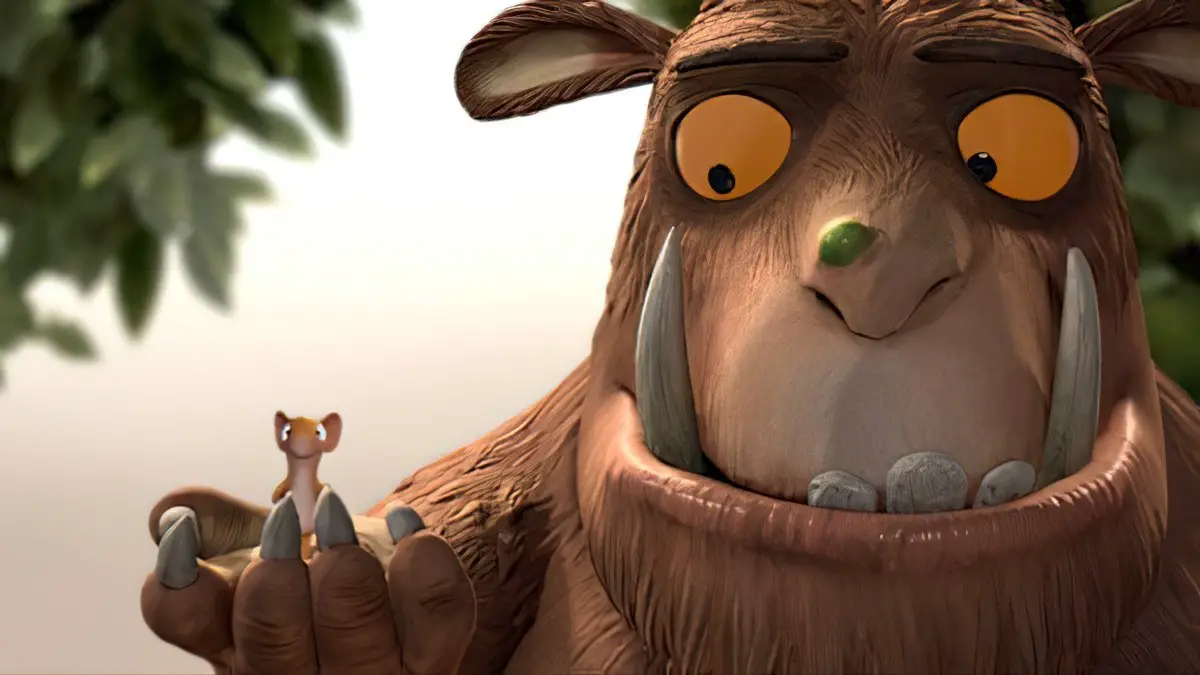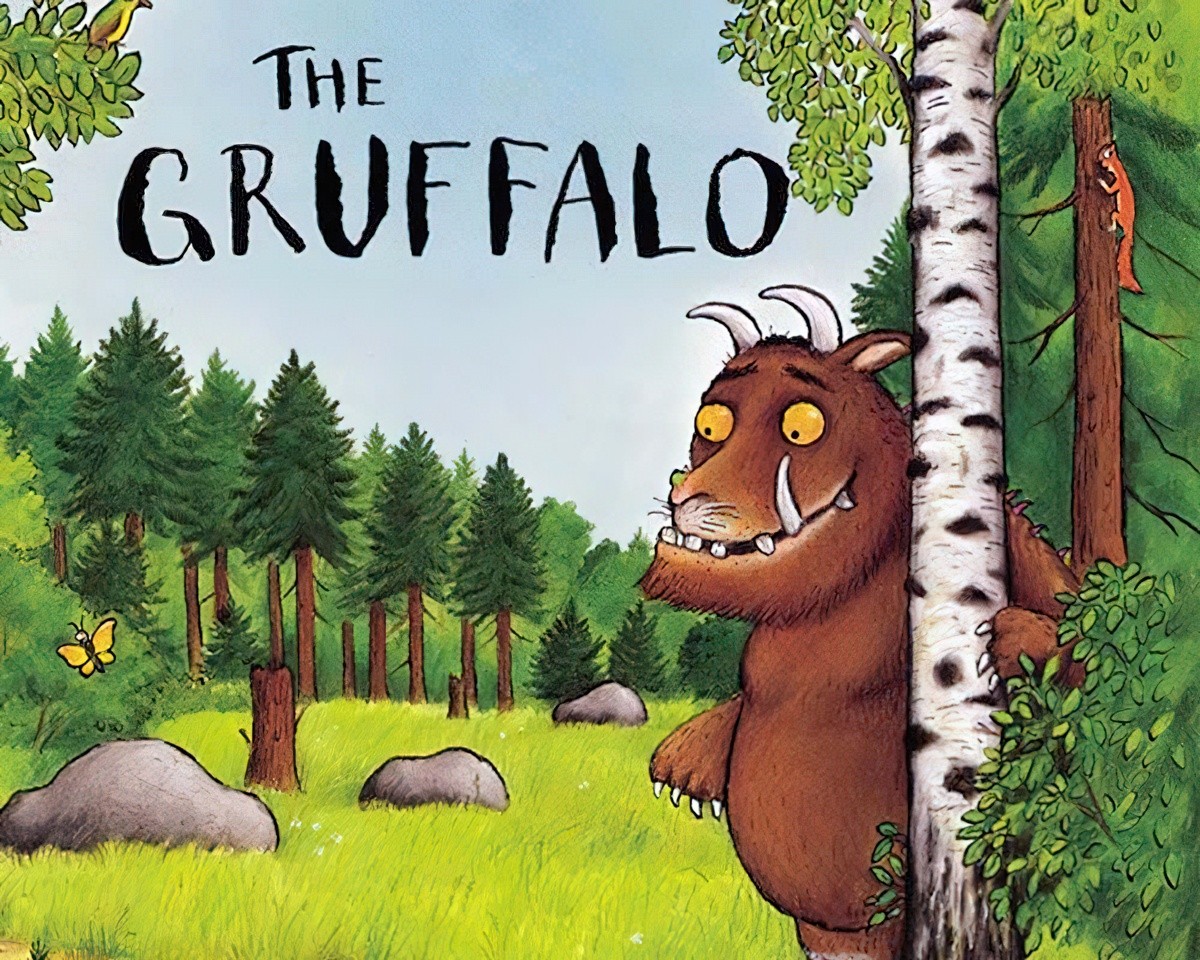This month I’m blogging a series aimed at teaching kids how to structure a story. This seven-step structure works for all forms of narrative. It works for picture books, songs, commercials, films and novels.
Today I take a close look at The Gruffalo by Julia Donaldson to show how universal structure exists behind all good stories. The Gruffalo is an example of mythic structure, which has been super successful as a story structure across cultures for the last 3000 years.
Julia Donaldson is a master at taking old folktales and rewriting them in rhyme for a contemporary audience. The Gruffalo draws heavily from Alexandra the Rock-eater: An old Rumanian tale, retold by Dorothy Van Woerkom and published in picture book form in 1978. Julia Donaldson uses the same device of tricking a formidable creature into thinking you’re much stronger than you are.
In the Romanian tale, an underdog hero convinces a dragon of her own considerable might. This is a familiar device in many folk tales. (For example, you might squeeze cheese but persuade a formidable opponent that you’re really squeezing buttermilk from a stone.) She’s trying to get rid of the local dragon in return for a gift of animals. She needs animals because she has 100 children to feed (all magic results from having wished for them.)
[The Gruffalo] was in her head for a year before she sat down to write. “Normally there’s a long time between germination and the writing.”
The Guardian
STORY STRUCTURE OF THE GRUFFALO
For more on mythic structure, see this post. Basically, a character goes on a journey, meets friends and foes, changes as a person (or animal, in this case), and returns home. Sometimes they find a new home. In any case, they’ll be different for their experiences than they were at the beginning. This is called a ‘character arc’.
WHO IS THE MAIN CHARACTER?
The mouse.
What’s wrong with Mouse? They’re small and therefore vulnerable.
But Mouse’s great strength is that they are a trickster character. The trickster is a super popular archetype in stories from every era. For a successful story (or scene), a trickster character is your absolute best bet. Go ahead and create characters who play tricks to get what they want. You may not approve of what your characters do morally, but readers love tricksters and their tricks.
What is she wrong about?
She thinks monsters aren’t real.
WHAT DO THEY WANT?
Mouse is off on a journey. We don’t know where s/he is going, but Mouse tells everyone along the way that they are off to see the Gruffalo. Obviously, this is not the mouse’s real desire. Mouse doesn’t think Gruffalos really exist. We’ll never know where Mouse is really going. I’d say they’re off to find nuts, with no particular destination in mind.
OPPONENT/MONSTER/BADDIE/ENEMY/FRENEMY
Mouse encounters only baddies on this trip — no true helpers/mentors. Mice tend to have a lot of opponents because they are small. That puts them near the bottom of the mammalian food chain. Mice are popular characters in children’s stories because both mice and children are small. So the mouse is a natural stand-in for the child.
Because Mouse is a trickster, s/he quickly turns the Gruffalo into an ally, even though s/he didn’t even believe in Gruffalos until meeting one.

WHAT’S THE PLAN?
The plan is to walk through the forest freely by telling opponents that they are off to meet a Gruffalo, scaring everyone off.
In many stories the initial plan doesn’t work and has to be changed. Our quick-thinking Mouse does not disappoint. When she realises the Gruffalo is real she decides to trick the Gruffalo into thinking they themself is fearsome by having Gruffalo walk behind.
Julia Donaldson has done something masterful here, pulling off what writers call a reversal. The reader now knows that the reason all those other animals were scared of the Gruffalo isn’t just because they’re easily duped — it’s because the Gruffalo really does exist. Perhaps Mouse heard about the Gruffalo but didn’t believe it was real… until this story.
BIG STRUGGLE
In stories with mythic structure, there won’t be just the one big struggle. There will be a series of them, increasing in intensity until the final showdown. There is a minor standoff every time Mouse meets a creature who wants to eat them. When Mouse is surprised to see the Gruffalo, that’s another. Then the story works in reverse, very similar to what Roald Dahl did with The Great Big Enormous Crocodile. With The Gruffalo right behind them, Mouse meets all of those animal opponents again, this time scaring them.
So what’s the Big Struggle? It doesn’t consist of much — it’s that ending scene — we might call it the climax. Mouse doesn’t need The Gruffalo anymore, so talks about Gruffalo Crumble, scaring The Gruffalo away.
Mouse has won.
WHAT DOES THE CHARACTER LEARN?
At a surface level, Mouse has learned that Gruffalos really do exist.
At a deeper level, Mouse has learned that wits can overcome size in any battle. Pessimistically, the reader is reminded that size really does equal scary, and if you’re not big enough yourself, you can use your wits to rope in someone bigger.
At an even deeper level, we might posit all sorts of psychological theories about how if you pretend for long enough, pretence will become your reality. Bluster over substance can work. Fake it til you make it…
HOW WILL LIFE BE DIFFERENT FROM NOW ON?
The final page shows Mouse eating nuts and everything is good. For Mouse, life will continue as before.
WHAT I BRING TO THE STORY
I imagine Mouse is a little more confident about their abilities as a trickster now, and even when hearing scary stories, will know that scary situations can be turned to her benefit.
SETTING OF THE GRUFFALO
Axel Scheffler’s illustrations are well-suited to Julia Donaldson’s stories because although many of the stories feature scary characters in forests, over boggy marshes (Room On The Broom) and on lonesome highways (The Highway Rat), the colour palette Scheffler uses is colourful and bright even when the atmosphere is raining and dark.
Forests and fairy tales go together. If you want to add danger and intrigue to your story, you can place your cast in the middle of a forest, or if they live in a town, put that town right next to a forest. That way, there’s always the threat that something will come out of the forest. Sometimes it does, sometimes it doesn’t. Doesn’t matter if you use the forest in this way. The existence of a nearby forest is enough.
COMPARE AND CONTRAST
A picture book writer very similar to Julia Donaldson is New Zealand’s Joy Cowley, who also writes rhyming picture books using ancient tales as inspiration. If I told you Nickety Nakkety Noo Noo had been written by Joy Cowley, or that Joy Cowley had written The Gruffalo, you’d probably believe me.
FURTHER READING
The Gruffalo was released in 1999, and met with immediate success. The book won the prestigious Smarties prize, which Donaldson accepted wearing a Gruffalo hand puppet. At the time she was working as a writer in residence at a school in Easterhouse, a deprived area of Glasgow. When Donaldson returned from the ceremony, the children gave her a gold star.The Gruffalo sparked a surge of creativity and a run of bestsellers. But away from books, Donaldson’s home life was fraught with difficulty. Hamish, the eldest of her three sons, suffered from depression and psychosis, and was hospitalised. He was eventually diagnosed with schizoaffective disorder. In 2003, Donaldson’s nephew Gaius, who also suffered from depression, died by suicide. A month later, Hamish killed himself. He was 25.
The Guardian

